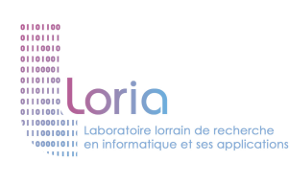⚠️ DEPRECATED • Grew • Python library ⚠️
⚠️ This library was released with the book Application of Graph Rewriting to Natural Language Processing. It is now deprecated. Please use grewpy for all new developement.
1.1. Creating a graph
Create an empty graph:
g = dict()
Add a node W1 labelled the to g:
g['W1'] = ('the', [])
Add a second and a third node, with the edges which connect them
g['W2'] = ('child', [])
g['W3'] = ('plays', [])
g['W3'][1].append(('suj', 'W2'))
g['W2'][1].append(('det', 'W1'))
Print the result
g
{'W2': ('child', [('det', 'W1')]), 'W3': ('plays', [('suj', 'W2')]), 'W1': ('the', [])}
Define construction functions
def add_node(g, u, a):
#Add a node u labeled a in graph g
g[u] = (a, [])
def add_edge(g, u, e, v):
# Add an edge labeled e from u to v in graph g
if (e, v) not in g[u][1]:
g[u][1].append( (e, v) )
add two more nodes
add_node(g, 'W4', 'the')
add_node(g, 'W5', 'fool')
add_edge(g, 'W3', 'obj', 'W5')
add_edge(g, 'W5', 'det', 'W4')
Using NLTK to build a flat graph (See NLTK installation page if necessary)
import nltk
word_list = nltk.word_tokenize("She takes a glass")
word_graph = dict()
for i in range(len(word_list)):
add_node(word_graph, 'W%s' % i, word_list[i])
for i in range(len(word_list) - 1):
add_edge(word_graph, 'W%s' % i, 'SUC', 'W%s' % (i + 1))
word_graph
{'W2': ('a', [('SUC', 'W3')]), 'W0': ('She', [('SUC', 'W1')]), 'W3': ('glass', []), 'W1': ('takes', [('SUC', 'W2')])}
1.2. Feature structures
Build a feature structure
fs_plays = {'phon' : 'plays', 'cat' : 'V'}
and read in it
fs_plays['cat']
'V'
Rebuild previous example with feature structures
g = dict()
add_node(g, 'W1', {'phon' : 'the', 'cat' : 'DET'} )
add_node(g, 'W2', {'phon' : 'child', 'cat' : 'N'} )
add_node(g, 'W3', {'phon' : 'plays', 'cat' : 'V'} )
add_node(g, 'W4', {'phon' : 'the', 'cat' : 'DET'})
add_node(g, 'W5', {'phon' : 'fool', 'cat' : 'N'})
add_edge(g, 'W2', 'det', 'W1')
add_edge(g, 'W3', 'suj', 'W2')
add_edge(g, 'W3', 'obj', 'W5')
add_edge(g, 'W5', 'det', 'W4')
Use the basic POS-tagger provided with NLTK
import nltk
word_list = nltk.word_tokenize("She takes a glass")
tag_list = nltk.pos_tag(word_list)
feat_list = [{'phon':n[0], 'cat':n[1]} for n in tag_list]
t_graph = {'W%s' % i : (feat_list[i], []) for i in range(len(tag_list))}
for i in range(len(tag_list)-1):
add_edge(t_graph, 'W%s' % i, 'SUC', 'W%s' % (i+1))
t_graph
{'W2': ({'phon': 'a', 'cat': 'DT'}, [('SUC', 'W3')]), 'W0': ({'phon': 'She', 'cat': 'PRP'}, [('SUC', 'W1')]), 'W3': ({'phon': 'glass', 'cat': 'NN'}, []), 'W1': ({'phon': 'takes', 'cat': 'VBZ'}, [('SUC', 'W2')])}
1.3. Information searches
Find the label or feature structure of a node
g['W4'][0]
{'phon': 'the', 'cat': 'DET'}
Functions to get label or the list of successors
def get_label(g, u):
return g[u][0]
def get_sucs(g, u):
return g[u][1]
1.3.1. Access to nodes
Get the list of nodes identifiers
nodes = g.keys()
Get the list of verbs
verbs = []
for u in nodes:
if get_label(g, u)['cat'] == 'V':
verbs.append(u)
or, with comprehension
verbs = [ u for u in g if get_label(g, u)['cat'] == 'V' ]
1.3.2. Extracting edges
Get the list of edges
triplets = [ (s, e, t) for s in g for (e, t) in get_sucs(g, s) ]
or the same with a loop:
triplets = []
for s in g:
for (e, t) in get_sucs(g, s):
triplets.append( (s, e, t) )
Extract the pairs of nodes linked by a subject relationship
subject_verbs = [ (s, v) for (v, e, s) in triplets if e=='suj' ]
A function to check if there is an edge between two nodes u and v
def are_related(g, u, v):
triplets = [(s, e, t) for s in g for (e, t) in get_sucs(g, s)]
for (s, e, t) in triplets:
if (s, t) == (u, v):
return True
return False
Check if a node is a root node (i.e. without incoming edge)
def is_root(g, u):
triplets = [(s, e, t) for s in g for (e, t) in get_sucs(g, s)]
for (s, e, t) in triplets:
if t == u:
return False
return True
1.4. Recreating an order
Using the convention explained in the book, we can reconstruct the sentence corresponding to a graph using the following function
def get_phonology(g):
def get_idx(node): #gets the float after 'W' in node if any
import re #for regular expressions
word_id = re.search(r'W(\d+(\.\d+)?)', node)
return word_id.group(1) if word_id else None
words = {get_idx(node) : get_label(g, node)['phon']
for node in g if get_idx(node)}
return ' '.join([ words[idx] for idx in sorted(words)])
get_phonology(g)
'the child plays the fool'
1.5. Using patterns with the Grew library
To run the next part of the chapter, the Grew library must be imported and the Grew tool must be started. The next two lines are then required:
import grew
grew.init()
Build a graph with Grew syntax
g = grew.graph('''graph {
W1 [phon="the", cat=DET];
W2 [phon="child", cat=N];
W3 [phon="plays", cat=V];
W4 [phon="the", cat=DET];
W5 [phon="fool", cat=N];
W2 -[det]->W1;
W3 -[suj]->W2;
W3 -[obj]->W5;
W5 -[det]->W4;
}''')
⚠️ the graph format used here is deprecated and will be removed in the future. Grew now uses either the Conll format or the JSON format.
Search for a specific pattern; each line below can be executed separately (in comment, the expected output)
grew.search ("pattern { X[cat=V] }", g) # [{'nodes': {'X': 'W4'}, 'edges': {}}, {'nodes': {'X': 'W1'}, 'edges': {}}]
grew.search ("pattern { X[cat=DET] }", g) # [{'nodes': {'X': 'W4'}, 'edges': {}}, {'nodes': {'X': 'W1'}, 'edges': {}}]
grew.search ("pattern { X[cat=ADJ] }", g) # []
grew.search ("pattern { X[cat=V]; Y[]; X -[suj]-> Y }", g) # [{'nodes': {'Y': 'W2', 'X': 'W3'}, 'edges': {}}]
grew.search ("pattern { X[cat=V]; X -[suj]-> Y }", g) # [{'nodes': {'Y': 'W2', 'X': 'W3'}, 'edges': {}}]
grew.search ("pattern { X[cat=V]; e:X -[suj]-> Y }", g) # [{'nodes': {'Y': 'W2', 'X': 'W3'}, 'edges': {'e': {'source': 'W3', 'label': 'suj', 'target': 'W2'}}}]
grew.search ("pattern { X[] } without { *->X }", g) # [{'nodes': {'X': 'W3'}, 'edges': {}}]
⚠️ the encoding of the solution in the list is different from the one described in the book.
1.5.2 Common pitfalls
1.5.2.1. Multiple choice edge searches
g0 = grew.graph('''graph {
W1 [phon=ils, cat=PRO];
W2 [phon="s'", cat=PRO];
W3 [phon=aiment, cat=V];
W3 -[suj]-> W1;
W3 -[obj]-> W1;
}''')
grew.search ("pattern { X -[suj|obj]-> Y }", g0)
[{'nodes': {'Y': 'W1', 'X': 'W3'}, 'edges': {}}, {'nodes': {'Y': 'W1', 'X': 'W3'}, 'edges': {}}]
Note the field edges is empty because the matched edge is anonymous.
If and identifier e is given to the edge in the pattern, the edge appears in the output:
grew.search ("pattern { e: X -[suj|obj]-> Y }", g0)
[{'nodes': {'Y': 'W1', 'X': 'W3'}, 'edges': {'e': {'source': 'W3', 'label': 'suj', 'target': 'W1'}}}, {'nodes': {'Y': 'W1', 'X': 'W3'}, 'edges': {'e': {'source': 'W3', 'label': 'obj', 'target': 'W1'}}}]
1.5.2.2. Anonymous nodes
m1 = 'pattern{ P[phon="en",cat=P]; V[cat=V]; V-[obj]-> *}'
m2 = 'pattern{ P[phon="en",cat=P]; V[cat=V]; V-[obj]-> O}'
g1 = grew.graph('''graph{
W1 [phon="en", cat=P];
W2 [phon="prend", cat=V];
W2 -[obj]-> W1;
}''')
grew.search(m1, g1) # 1 solution
grew.search(m2, g1) # 0 solution
g2 = grew.graph('''graph{
W1 [phon="en", cat=P];
W2 [phon="connait", cat=V];
W3 [phon="la", cat=Det];
W4 [phon="fin", cat=N];
W2 -[det]->W3;
W2 -[mod]->W1;
W2 -[obj]->W4;
}''')
grew.search(m1, g2) # 1 solution [{'nodes': {'V': 'W2', 'P': 'W1'}, 'edges': {}}]
grew.search(m2, g2) # 1 solution [{'nodes': {'V': 'W2', 'P': 'W1', 'O': 'W4'}, 'edges': {}}]
1.5.2.3. Multiple without clauses
g3 = grew.graph('''graph{
W1 [phon=John, cat=NP];
W2 [phon=reads, cat=V ];
W3 [phon=the, cat=Det];
W4 [phon=book, cat=N];
W2 -[suj]-> W1;
W2 -[obj]-> W4;
W4 -[det]-> W3;
}''')
g4 = grew.graph('''graph{
W1 [phon=John, cat=NP];
W2 [phon=reads, cat=V ];
W3 [phon=the, cat=Det];
W4 [phon=book, cat=N];
W5 [phon=today, cat=ADV];
W2 -[suj]-> W1;
W2 -[obj]-> W4;
W4 -[det]-> W3;
W2 -[mod]-> W5;
}''')
m3 = "pattern{Y-[suj]->X} without{Y-[obj]->Z; Y-[mod]->T}"
m4 = "pattern{Y-[suj]->X} without{Y-[obj]->Z} without{Y-[mod]->T}"
grew.search(m3, g3) # 1 solution
grew.search(m4, g3) # 0 solution
grew.search(m3, g4) # 0 solution
grew.search(m4, g4) # 0 solution
1.5.2.4. Double negations
g5 = grew.graph('''graph{
W1 [phon=dors, cat=V, m=imp];
W2 [phon="!", cat=PONCT];
}''')
m5 = "pattern { X[cat=V, t=fut] }"
m6 = "pattern { X[cat=V] } without{ X[t<>fut] }"
grew.search(m5, g5) # 0 solution
grew.search(m6, g5) # 1 solution
1.5.2.5. Double edges
g0 = grew.graph('''graph {
W1 [phon=ils, cat=PRO];
W2 [phon="s'", cat=PRO];
W3 [phon=aiment, cat=V];
W3 -[suj]-> W1;
W3 -[obj]-> W1;
}''')
grew.search("pattern { e : X -> Y ; f : X -> Y }", g0) # 4 solutions
1.6. Graph rewriting
The syntactic structure for a French sentence with a passive agent
g = grew.graph('''graph{
W1 [phon="John",cat=NP];
W2 [phon="est",cat=V ];
W3 [phon="mordu", cat=V, m=pastp];
W4 [phon="par",cat=P ];
W5 [phon="le", cat=D];
W6 [word="chien",cat=NP];
W3 -[suj]-> W1;
W3 -[aux.pass]-> W2;
W3 -[p_obj.agt]-> W4;
W6 -[det]-> W5;
W4 -[obj.p]-> W6;
}''')
Example of rule dealing with passive agent
r = """rule passiveAgt {
pattern {
V [cat=V, m=pastp];
V -[aux.pass]-> AUX;
e: V -[suj]-> SUJ;
P [phon=par]; V -[p_obj.agt]-> P;
P -[obj.p]-> A;
} commands {
del_node P;
del_node AUX;
add_edge V -[suj]-> A;
add_edge V -[obj]-> SUJ;
del_edge e;
} }"""
Apply the rule to the graph
grew.run(r, g, 'passiveAgt')
[{'W6': [{'cat': 'NP', 'word': 'chien'}, [['det', 'W5']]], 'W5': [{'cat': 'D', 'phon': 'le'}, []], 'W3': [{'cat': 'V', 'm': 'pastp', 'phon': 'mordu'}, [['suj', 'W6'], ['obj', 'W1']]], 'W1': [{'cat': 'NP', 'phon': 'John'}, []]}]
1.6.2. From rules to strategies
In order to run examples for this section, we put the two rules passiveAgt and du2dele into the same rewriting system:
rs = grew.grs ("""
rule passiveAgt {
pattern {
V [cat=V, m=pastp];
V -[aux.pass]-> AUX;
e: V -[suj]-> SUJ;
P [phon=par]; V -[p_obj.agt]-> P;
P -[obj.p]-> A;
}
commands {
del_node P;
del_node AUX;
add_edge V -[suj]-> A;
add_edge V -[obj]-> SUJ;
del_edge e;
}
}
rule du2dele {
pattern {
A [cat="P+D", phon="du"]; N [cat=N];
A -[obj.p]-> N;
}
commands {
add_node D:> A; D.cat=D ; D.phon="le" ;
A.cat=P; A.phon="de";
add_edge N -[det]-> D;
}
}
strat S1 { du2dele }
""")
The code for the two French sentences is given below:
- (1.1) La porte du jardin du voisin
- (1.2) Le chien du voisin est pris par John
sent_1_1 = grew.graph('''graph{
W1 [phon=La, cat=D];
W2 [phon=porte, cat=N];
W3 [phon=du, cat="P+D"];
W4 [phon=jardin, cat=N];
W5 [phon=du, cat="P+D"];
W6 [phon=voisin, cat=N];
W2 -[det]-> W1;
W2 -[dep]-> W3;
W3 -[obj.p]-> W4;
W4 -[dep]-> W5;
W5 -[obj.p]-> W6;
}''')
sent_1_2 = grew.graph('''graph{
W1 [phon=Le, cat=D];
W2 [phon=chien, cat=N];
W3 [phon=du, cat="P+D"];
W4 [phon=voisin, cat=N];
W5 [phon=est, cat=V];
W6 [phon=pris, cat=V, m=pastp];
W7 [phon=par, cat=P];
W8 [phon=John, cat=N];
W2 -[det]-> W1;
W2 -[dep]-> W3;
W3 -[obj.p]-> W4;
W6 -[suj]-> W2;
W6 -[aux.pass]-> W5;
W6 -[p_obj.agt]-> W7;
W7 -[obj.p]-> W8;
}''')
Apply one rule to a graph
As the strategy S1 is defined as one rule du2dele, we can apply the rule to the sentence (1.1) with one of the two equivalent commands below:
grew.run(rs,sent_1_1,"S1")
grew.run(rs,sent_1_1,"du2dele")
The output contains two graphs resulting of the application of the rule to the first or the second du in the sentence.
1.6.2.1. Alternative
grew.run(rs,sent_1_2,"Alt (passiveAgt, du2dele)")
1.6.2.2. Sequence
grew.run(rs,sent_1_2,"Seq (du2dele, passiveAgt)")
1.6.2.3. Pick
grew.run(rs,sent_1_1,"Pick (S1)")
This produces unpredictably one of the two graphs:
1.6.2.4. Iteration
grew.run(rs,sent_1_1,"Iter (S1)")
1.6.2.5. Test
grew.run(rs,sent_1_1,"If(passiveAgt,Seq(passiveAgt, Iter(du2dele)), Iter(du2dele))")
grew.run(rs,sent_1_2,"If(passiveAgt,Seq(passiveAgt, Iter(du2dele)), Iter(du2dele))")
1.6.2.6 Try
grew.run(rs,sent_1_1,"Try(passiveAgt)")
grew.run(rs,sent_1_2,"Try(passiveAgt)")
1.6.3 Using lexicons
This features will be available in an upcoming release of Grew which should appear soon!




